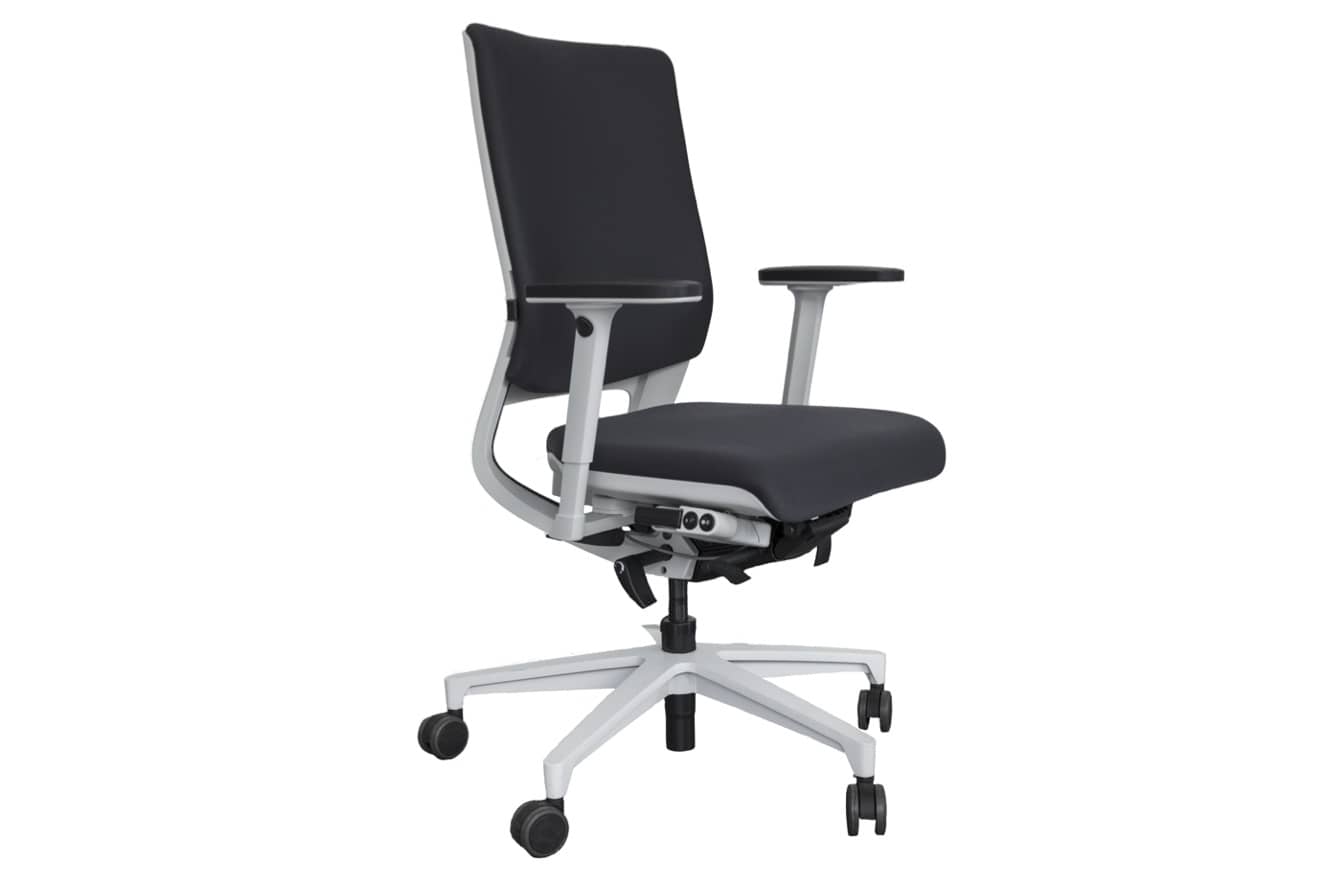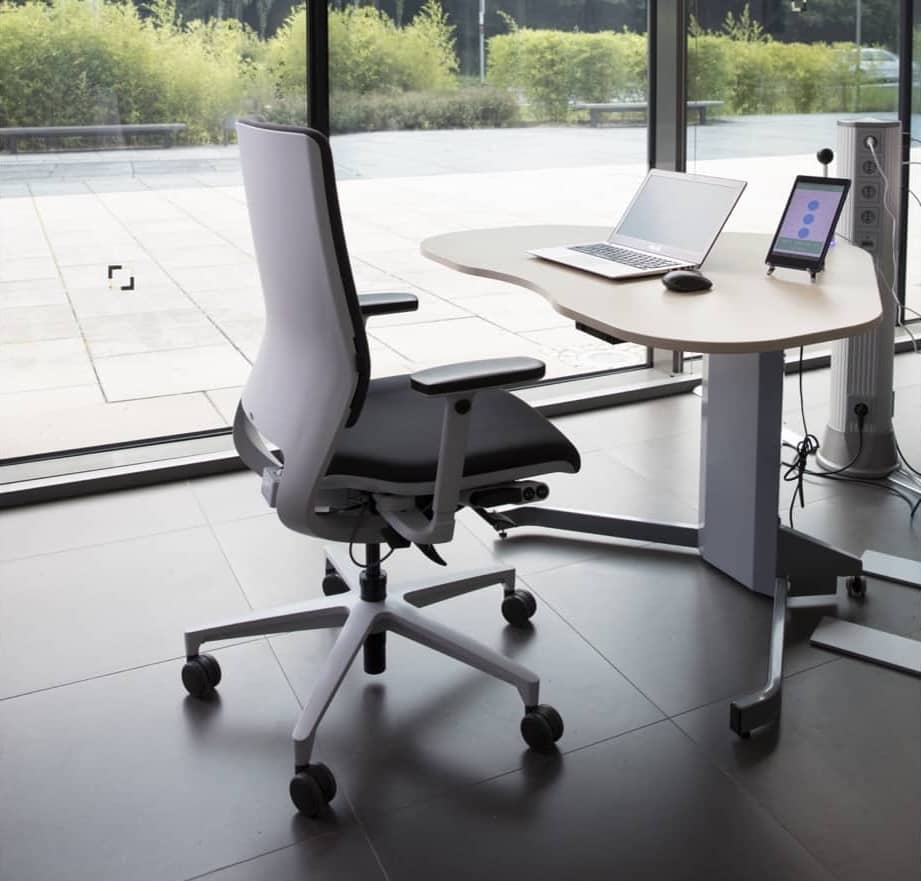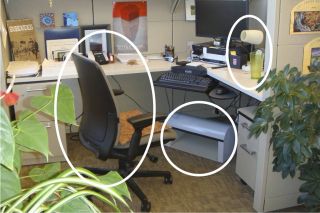
www.buildingsandcities.org/insights/commentaries/personal-comfort-systems-lessons.html
Personal Comfort Systems: Lessons from the creation of the 'Klimastuhl'

Part of a a new series on Personal Comfort Systems: How barriers to this promising approach can be overcome.
Sabine Hoffmann (Technical University of Kaiserslautern) explains how an office chair with heating and cooling was developed and commercialised.
Background
Various researchers in the domain of thermal comfort have been investigating the use of chairs as personal heating and cooling devices for almost two decades. However, it was only in 2016 that a medium-sized office chair company in Germany 2016 brought a product to market which integrated a heating and cooling functionality, the 'Klimastuhl'. (The German term 'Klimastuhl' is difficult to translate to English language as Klima here refers to the direct ambient environment and stuhl means chair.) As providers of office chairs, they knew the world of 'new work' by heart and were familiar with the frequent complaints about thermal conditions in offices. In response, the company's engineers combined their professional experience fabricating ergonomic and well-designed office chairs with an existing and proven technology from the automotive industry, to provide a promising innovation in their area of expertise--office chairs, not thermal comfort.
Given the requirements and expectations for open-space offices, the development of a chair with heating and cooling function was only possible when rechargeable batteries were available at a reasonable price. A tethered chair, such as most research prototypes in the past, would have been unthinkable. Luckily, of the rise of smart phones and other rechargeable devices meant no one complained about the chair containing a lithium-ion battery or needing to regularly recharge it.
Prior to the market introduction, the company's R&D engineers ran large-scale field tests to improve the functionalities and test the acceptance of the chair by potential clients. Based on the feedback of studies that were partially supported by thermal comfort experts, they improved the acoustics and user handling before finalizing the design. A well-thought-out marketing strategy helped to get the product started on the market. Their thorough knowledge of the market, use of reliable and established thermal technologies, and an adequate advertising strategy concluded in their successful introduction to the market.
Marketing: overcoming the barriers
The chair's initial success did not continue as expected by the manufacturer. One of the major barriers for a deep market penetration can be condensed in the experience from one of the first field studies: the chairs were provided to large enterprises for testing. The companies could keep the chairs for up to four weeks and evaluate their performance. To the surprise of everybody, one large automotive firm returned the chairs after the first week of use. Explaining the early return, they claimed that this new chair would raise too much covetousness amongst employees. To them it seemed impossible to distribute the chair to selected people only, as the desire for a chair with heating and cooling function would be high amongst the entire staff.
This anecdote demonstrates both the chair's strength and threat that it poses for clients. The increased desire for an innovative and comfort-enhancing product should not prevent companies from purchasing it in high volumes. However, cost unfortunately is often the decisive factor when buying office furniture. From the manufacturer's side the pricing of an innovative product needs to reflect the expenses for development and added technical features. So the 'Klimastuhl' is not inexpensive and is situated at the lower price range of top-notch office chairs. In particular, big companies with more than 100 employees tend to negotiate unbeatable prices for buying office chairs from the major chair manufacturers.
The chair's target market was identified as small and medium-size enterprises in which decisions are made or influenced by the HR department or even CEOs themselves. The idea was that in smaller firms the positive impact of the new chairs on satisfaction and motivation of the staff would be valued to a higher extent. Although this strategy worked out in some cases, the sales numbers still did not meet expectations. Unfortunately, some purchasers valued style (appearance) over comfort, and the chair's rather conservative form-follows-function paradigm was discounted. To counteract such reservations, the manufacturer introduced new fabrics and a more classy design to fulfil the expectations that some potential buyers have for a costly office chair.
Thermal comfort
What are the strengths and opportunities of the 'Klimastuhl'? The research team (that worked with the manufacturer during their final stage of product development) ran a controlled field study focusing on two questions:
- Will the use of the heating and cooling function lead to a higher level of thermal comfort in both warm and cool conditions?
- To what extent will lower room temperatures during the heating period and higher temperatures during the cooling period be accepted by the users of the 'Klimastuhl'?
The detailed results (Hoffmann and Boudier 2016) can be summarized as follows. In more than 80 % of the human subjects participating in the study, the heating function led to a significant increase in thermal comfort. The cooling function, provided by increased convective heat transfer through integrated fans, was more disputable but still approximately a third of the testers really enjoyed the functionality. While heating, the chair could provide thermal comfort at room temperatures of around 18 - 19 °C. For lower temperatures the discomfort originated from cold feet and hands for which the chair could not compensate. While cooling, an upper room temperature of 30 °C was still acceptable. Beyond that, the increased convection in the seat did not provide sufficient sensible heat transfer from the body to the environment. However, the latent heat transfer remained high and some people reported that the ventilation in the seat and the back of the chair felt like it was 'drying off the sweat' on a hot summer day.
These results proved not only the effectiveness at providing thermal comfort under extreme office conditions, but also made one of the major opportunities obvious: If the comfort temperature range provided by a central heating or cooling system could be extended by several degrees, enormous energy savings would be achievable. In consequence, this path became one of our main research areas.
Implications for HVAC

When the 'Klimastuhl' was first marketed, there was no simulation tool available to model both occupant behaviour (when using chairs with heating and cooling functions) and HVAC systems. Therefore we coupled a detailed, 16 body-segment model of physiology, sensation and comfort with a building simulation software to simulate the thermal-comfort-driven interaction of users with decentralized heating and cooling systems (Boudier et al. 2016). In the first step, the comfort prediction was integrated into a building controller for the central system to increase the dead-band for heating and cooling. Based on the field study, a lower setpoint of 18 °C was used for heating and an upper setpoint of 30 °C was used for cooling. Within this dead-band, the target temperature of the HVAC system was incrementally adjusted to the comfort evaluation of a virtual human being.
In the next step, we virtually provided the manikin with several decentralized devices including a mobile heating and cooling partition, a desk fan and the office chair with heating and cooling function. Now, if the virtual occupant experienced an uncomfortable thermal condition, she would operate her personal comfort system (PCS) first. While the occupant's thermal comfort was enhanced by means of the PCS, the central HVAC system was controlled to operate within the broader dead-band.
The results of this research can be found in Boudier (2021) in German and in Boudier and Hoffmann (2022) in a condensed form in English. The simulation results showed that the office chair performed best amongst the considered PCS devices at maintaining comfortable conditions while allowing the central system to be operated with a broader dead-band. A reduction of heating demand of up to 10 % could be achieved for German climate and similar reductions of cooling demand were achieved, especially when coupled with a desk fan for additional cooling of the head.
Next steps
The promising results of the theoretical study represent one of the major opportunities of the 'Klimastuhl'. The logical next step is to implement the coupling together of central HVAC systems with PCS in actual buildings. Researchers will have to partner with professionals in the domain of central HVAC systems and building automation to put into practice systems with decentralized personal comfort control and substantial energy savings.
References
Boudier, K. (2021). Modellierung der Interaktion von Gebäudenutzer*innen und Gebäudetechnik. Potenzialanalyse dezentraler Heiz- und Kühlsysteme hinsichtlich der thermischen Behaglichkeit und des Energieverbrauchs auf Basis eines adaptiven Gebäudereglers. (Doctoral dissertation, TU Kaiserslautern, Kaiserslauten). https://kluedo.ub.uni-kl.de/frontdoor/index/index/docId/6390
Boudier, K., Fiorentini, M., Hoffmann, S., Kalyanam, R. & Kokogiannakis, G. (2016). Coupling a thermal comfort model with building simulation for user comfort and energy efficiency. Proceedings of the Central European Symposium on Building Physics (CESBP) and BauSIM. Dresden. 481-487.
Boudier, K. & Hoffmann, S. (2022). Analysis of the potential of decentralized heating and cooling systems to improve thermal comfort and reduce energy consumption through an adaptive building controller. Energies, 15 (3), 1100. https://doi.org/10.3390/en15031100
Hoffmann, S. & Boudier, K. (2016). A new approach to provide thermal comfort in office buildings: A field study with heated and cooled chairs. Proceedings of Indoor Air Quality Ventilation & Energy Conservation in Buildings (IAQVEC). Incheon Songdo, Republic of Korea.
Latest Peer-Reviewed Journal Content
Youth engagement in urban living labs: tools, methods and pedagogies
N Charalambous, C Panayi, C Mady, T Augustinčić & D Berc
Co-creating urban transformation: a stakeholder analysis for Germany’s heat transition
P Heger, C Bieber, M Hendawy & A Shooshtari
Placemaking living lab: creating resilient social and spatial infrastructures
M Dodd, N Madabhushi & R Lees
Church pipe organs: historical tuning records as indoor environmental evidence
B Bingley, A Knight & Y Xing
A framework for 1.5°C-aligned GHG budgets in architecture
G Betti, I Spaar, D Bachmann, A Jerosch-Herold, E Kühner, R Yang, K Avhad & S Sinning
Net zero retrofit of the building stock [editorial]
D Godoy-Shimizu & P Steadman
Co-learning in living labs: nurturing civic agency and resilience
A Belfield
The importance of multi-roles and code-switching in living labs
H Noller & A Tarik
Researchers’ shifting roles in living labs for knowledge co-production
C-C Dobre & G Faldi
Increasing civic resilience in urban living labs: city authorities’ roles
E Alatalo, M Laine & M Kyrönviita
Co-curation as civic practice in community engagement
Z Li, M Sunikka-Blank, R Purohit & F Samuel
Preserving buildings: emission reductions from circular economy strategies in Austria
N Alaux, V Kulmer, J Vogel & A Passer
Urban living labs: relationality between institutions and local circularity
P Palo, M Adelfio, J Lundin & E Brandão
Living labs: epistemic modelling, temporariness and land value
J Clossick, T Khonsari & U Steven
Co-creating interventions to prevent mosquito-borne disease transmission in hospitals
O Sloan Wood, E Lupenza, D M Agnello, J B Knudsen, M Msellem, K L Schiøler & F Saleh
Circularity at the neighbourhood scale: co-creative living lab lessons
J Honsa, A Versele, T Van de Kerckhove & C Piccardo
Positive energy districts and energy communities: how living labs create value
E Malakhatka, O Shafqat, A Sandoff & L Thuvander
Built environment governance and professionalism: the end of laissez-faire (again)
S Foxell
Co-creating justice in housing energy transitions through energy living labs
D Ricci, C Leiwakabessy, S van Wieringen, P de Koning & T Konstantinou
HVAC characterisation of existing Canadian buildings for decarbonisation retrofit identification
J Adebisi & J J McArthur
Simulation and the building performance gap [editorial]
M Donn
Developing criteria for effective building-sector commitments in nationally determined contributions
P Graham, K McFarlane & M Taheri
Join Our Community

The most important part of any journal is our people – readers, authors, reviewers, editorial board members and editors. You are cordially invited to join our community by joining our mailing list. We send out occasional emails about the journal – calls for papers, special issues, events and more.
We will not share your email with third parties. Read more



Latest Commentaries
COP30 Report
Matti Kuittinen (Aalto University) reflects on his experience of attending the 2025 UN Conference of the Parties in Belém, Brazil. The roadmaps and commitments failed to deliver the objectives of the 2025 Paris Agreement. However, 2 countries - Japan and Senegal - announced they are creating roadmaps to decarbonise their buildings. An international group of government ministers put housing on the agenda - specifying the need for reduced carbon and energy use along with affordability, quality and climate resilience.
Building-Related Research: New Context, New Challenges
Raymond J. Cole (University of British Columbia) reflects on the key challenges raised in the 34 commissioned essays for Buildings & Cities 5th anniversary. Not only are key research issues identified, but the consequences of changing contexts for conducting research and tailoring its influence on society are highlighted as key areas of action.